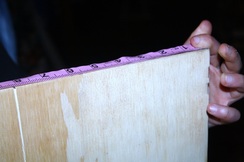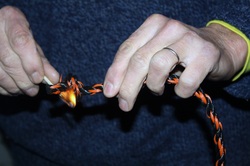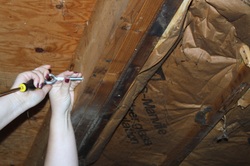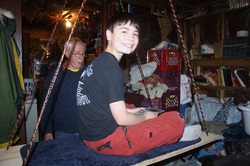|
By: Tikatia Morris Swinging is an activity enjoyed by neurologically diverse and neurotypicals alike. Many parents will whose children participate in occupational therapy services may have seen their children using a platform swing. These swings are helpful for building trunk support, learning balance and provide an excellent source of vestibular input. If you were to purchase a similar product to install within your home, you would probably spend several hundred dollars. Making a platform swing can save you money, as well as become an inclusive activity for the whole family in building the swing together. Materials You will also need: measuring tape hand drill with bit large enough to make a hole to fit the rope lighter carpet - we used a bath mat from Wal-Mart, but you can buy scrap carpet or measure to fit your board exactly staple gun and staples hammer a sturdy area either in your home or outside to place swing with lots of room for movement. Instructions  First, measure your board so that your holes are even on both sides and ends of your platform.  Once measured, position your drill straight above your marked spots and drill 4 holes into each corner. We measured about 2 inches away from each side for support reasons as well as to keep the wood from splinting.  Once you have your four holes drilled, staple your carpet square to the top of your swing. Since our builders used a bathmat, the carpet piece did not fit entirely around the piece of board. If you want to cover the board entirely, you will need to cut circles out over where your holes are and staple the carpet underneath.  Cut the rope into two pieces (ours were 11 feet each) and loop through the holes on each end lengthwise. Use a lighter or matches to seal the ends of the rope after knotting tightly. We doubled our knots for extra stability and thickness.  Install the eye screws first to a secure beam. This swing was installed in a basement and the eye screws were screwed into the support beams on the ceiling. The quick links are then attached to the eye screws and the rope is looped through the links. Now that your swing is put together make sure that a responsible adult tests the swing for strength and durability.  Once you determine that your swing has been installed successfully, and you've tested it for strength, enjoy!
1 Comment
Many parents of children with spectrum disorders spend years arguing with their local schools to demand a learning environment that will be ideal for their child. They fight, they push, they lobby, and sometimes they even win; but the majority of parents with children on the spectrum soon realize that a public school setting just isn't ideal for their children.
The homeschooling movement has been sweeping the nation, especially in the past 10 years. Parents are tired of the "one size fits all" mentality that most public school systems have to offer. They don't see their children thriving and see our nation's scores as a whole plummeting within our world society. And so, many are turning to homeschooling. There are many reasons why the average parent may turn to homeschooling for their children. This article's purpose is to focus primarily on the reasons why a parent of a child on the spectrum would homeschool their child. Distraction and Noise Let's face it, schools are loud. With anywhere from 20 to 35 children per classroom with the national average for elementary schools being roughly 25-27. For the average kid a class of that size can be distracting at best, for a child on the spectrum just being in the same room as that many people can make it impossible for them to focus. When you add in the noise of 27 pencils scratching, the occasional cough, ceiling fans or that buzzing noise from the florescent lighting, this becomes the grounds for a major sensory overload. Homeschooling parents have the ability to create a peaceful and quiet learning environment, and unless you're the Duggars, chances are you won't have 20 kids in your homeschool classroom. The ability to create an environment that is sensory friendly to a child with sensitivities is a huge bonus to homeschooling. Movement and Sensory Breaks Many autistic kids like to move. They don't want to sit at a desk in a classroom and "focus." Even the highest functioning ASD kids, love to fidget. Schools often tend to frown upon walking around the classroom, or taking a "spinning" break. Even with a good IEP, a child with autism may not be getting enough sensory breaks throughout their day. When parents of ASD kids homeschool, they have the ability to work closely with their children's therapists to create a sensory diet that will provide an optimal learning environment for their children. Spelling can be learned at the playground while swinging, Math can be covered while the child is spinning in the backyard, and there are plenty of quiet dark places to get a moment of peace when it is warranted. Socialization The biggest concern many parents and professionals alike bring up when concerned with homeschooling is the socialization question. Often this can be the reason why a parent will choose a public school over homeschooling. They look at their spectrum kid and think, "my child needs so much help socializing, that being in school around that many kids all day must be what is best for him." When it comes to socialization, it's not the quantity that matters, but the quality. Parents of autistic kids know that their child will adapt much better to a one-on-one social experience than one within a group. Homeschooling gives the parent freedom to plan social experiences for their children during times when their child is at his or her best, they have the ability to focus on specific socialization goals in their timing. Children thrive in this environment because they are not bombarded with tons of people around them all day, they are able to adjust to social engagements easier. Individualized Learning Many spectrum kids have their "thing." That one subject that they just love. Then they have those other things that they just hate. You may see an autistic child who thrives in math, but still can't read at age 8. Homeschooling allows the parent to let their children soar in the subjects that they thrive in, while allowing time for extra help in those areas where they struggle. Even neurotypical children tend to excel in certain areas and struggle in others, why just because children are a certain age, must they study what is "age appropriate" for that age, when their understanding may be far beyond that. Homeschooling is one of the only educational choices out there that allows for a truly individualized learning experience. As seen above, homeschooling offers a plethora of adjustments that can be individualized to meet your spectrum child's needs. This is just the first in a series of articles pertaining to homeschooling, please check back in soon for more posts. |
Categories
All
Archives
December 2021
|
Photo from Hayzphotos




 RSS Feed
RSS Feed
